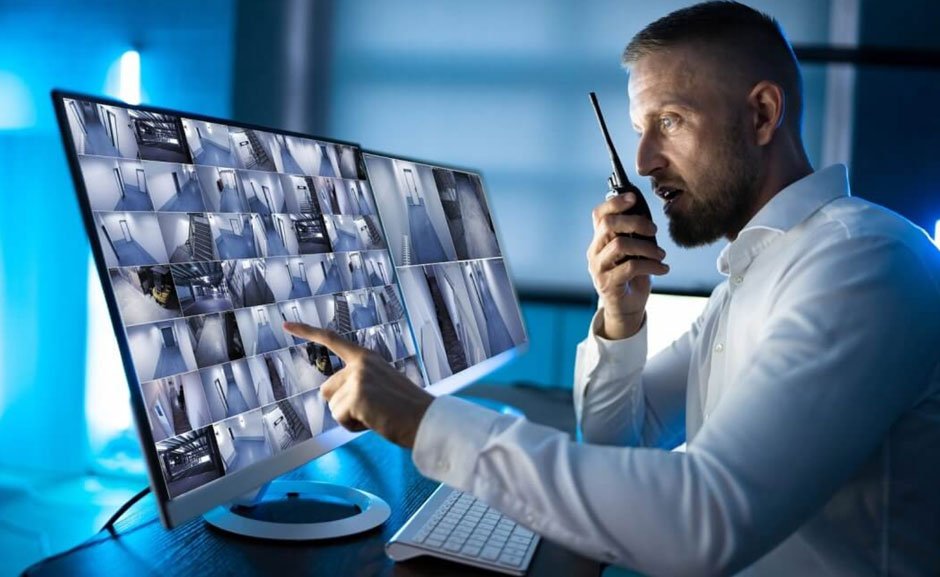Skip to the good bit
ToggleIn today’s fast-paced business world, security is a top priority for office buildings. With increasing threats ranging from vandalism and theft to unauthorized access and workplace violence, businesses need robust solutions to protect employees, assets, and sensitive information. One of the most effective security measures available is office building real-time video monitoring, which provides round-the-clock surveillance and immediate response to potential threats.
The Growing Need for Enhanced Security in Office Buildings
Office buildings house valuable assets, including expensive equipment, confidential data, and, most importantly, employees and visitors. Traditional security measures, such as alarm systems and on-site security personnel, are no longer sufficient on their own. Criminals have become more sophisticated, and workplace security risks have evolved, necessitating advanced solutions that can provide proactive rather than reactive security.
Real-time video monitoring bridges this gap by offering continuous surveillance that allows security teams to respond immediately to any suspicious activity. Unlike traditional CCTV systems, which only provide footage for later review, real-time monitoring leverages artificial intelligence (AI) and human security professionals to detect and prevent incidents as they occur.
How Real-Time Video Monitoring Works
Real-time video monitoring involves strategically placed security cameras connected to a network that allows live surveillance of office premises. These systems are monitored by trained security professionals in control centers, who analyze footage in real-time to identify unusual or suspicious activity. Advanced AI-powered analytics further enhance security by detecting anomalies, such as unauthorized access, unattended objects, or unusual movement patterns, and triggering instant alerts.
Some key components of an effective office building real-time video monitoring system include:
- High-Definition (HD) Cameras: Provide clear, detailed images for accurate identification of individuals and activities.
- Artificial Intelligence (AI) and Machine Learning: Detect threats, recognize patterns, and filter out false alarms.
- Remote Monitoring Centers: Staffed by security experts who can intervene and notify authorities immediately.
- Integration with Access Control Systems: Ensures that only authorized personnel can enter restricted areas.
- Cloud-Based Storage and Analytics: Allows easy access to footage for incident investigations and compliance purposes.
Key Benefits of Real-Time Video Monitoring for Office Buildings
1.Crime Prevention and Deterrence
One of the biggest advantages of real-time video monitoring is its ability to deter criminal activity. The mere presence of security cameras discourages potential criminals, while live monitoring ensures that any suspicious activity is immediately addressed. In the event of an attempted break-in, security personnel can alert law enforcement in real time, increasing the chances of apprehending the intruder before any damage is done.
2.Enhanced Employee Safety
A safe work environment is essential for productivity and morale. Real-time video monitoring helps protect employees by detecting threats such as unauthorized intrusions, workplace violence, or suspicious individuals loitering near entrances. In cases of medical emergencies, security teams can quickly notify first responders and guide them to the exact location of the incident.
3.Protection of Sensitive Information and Assets
Office buildings often store sensitive data, intellectual property, and valuable equipment. Real-time monitoring prevents unauthorized access to restricted areas, such as server rooms or executive offices, reducing the risk of data breaches and corporate espionage. Security teams can instantly respond if someone attempts to tamper with sensitive information or remove company assets without authorization.
4.Cost Savings Compared to On-Site Security Teams
Hiring and maintaining a full-time security staff can be costly. While on-site security personnel are valuable, real-time video monitoring enhances their effectiveness by allowing fewer guards to cover a larger area. AI-driven surveillance reduces the need for excessive manpower while ensuring a high level of security, leading to significant cost savings over time.
5.Faster Incident Response Time
Unlike traditional security measures that only provide post-incident evidence, real-time video monitoring enables immediate intervention. Security teams can communicate directly with law enforcement, guiding them to the precise location of an ongoing incident. This rapid response minimizes potential damages and increases the likelihood of preventing crime before it escalates.
6.Compliance with Legal and Insurance Requirements
Many industries require businesses to maintain strict security protocols to comply with regulations and insurance policies. Real-time monitoring ensures that companies meet these security standards, reducing liability risks and potentially lowering insurance premiums. In case of disputes or legal issues, recorded footage serves as reliable evidence.
The Role of AI in Modern Video Surveillance
Artificial intelligence has revolutionized real-time video monitoring by making security systems smarter and more efficient. AI-powered surveillance systems can:
- Identify Suspicious Behavior: AI algorithms detect anomalies in behavior patterns, such as loitering in restricted areas or aggressive movements.
- Recognize Faces and License Plates: Facial recognition technology helps identify unauthorized individuals, while license plate recognition can track vehicles entering or exiting the premises.
- Filter False Alarms: AI reduces the number of unnecessary alerts by distinguishing between real threats and benign activities, such as an employee working late.
Implementing Real-Time Video Monitoring in Office Buildings
Businesses looking to implement office building real-time video monitoring should consider the following steps:
- Conduct a Security Assessment: Identify potential vulnerabilities and determine the best camera placements.
- Choose a Reliable Security Provider: Work with a reputable security company that offers 24/7 monitoring and AI-driven analytics.
- Integrate with Existing Security Systems: Combine video monitoring with access control, alarm systems, and emergency response protocols.
- Train Employees: Educate staff on security policies and how they can contribute to maintaining a secure workplace.
- Regularly Update and Maintain Equipment: Ensure cameras, software, and networks are up to date to maintain optimal performance.
Conclusion: A Smarter, Safer Future for Office Security
With the rise of sophisticated security threats, office building real-time video monitoring is no longer a luxury but a necessity. This advanced surveillance solution offers businesses enhanced crime prevention, faster incident response times, and significant cost savings compared to traditional security methods. By investing in real-time monitoring, companies can protect their employees, assets, and sensitive information, ensuring a safer and more secure workplace.
As technology continues to evolve, integrating AI-driven security solutions will further enhance office building safety, providing business owners with peace of mind and uninterrupted operations. Now is the time for organizations to embrace real-time video monitoring and take their security strategies to the next level.







